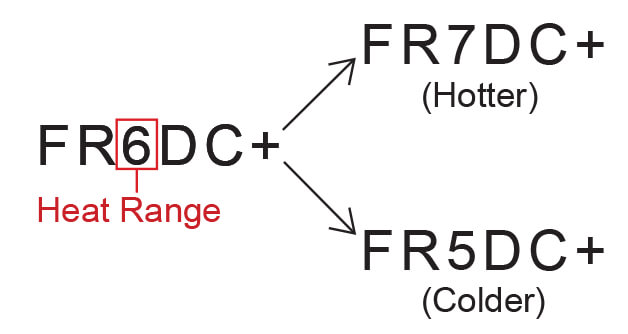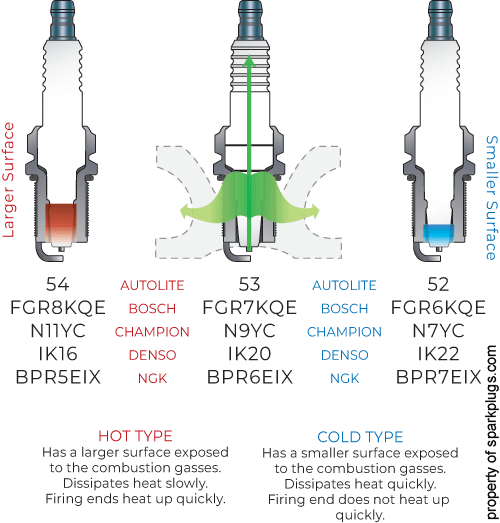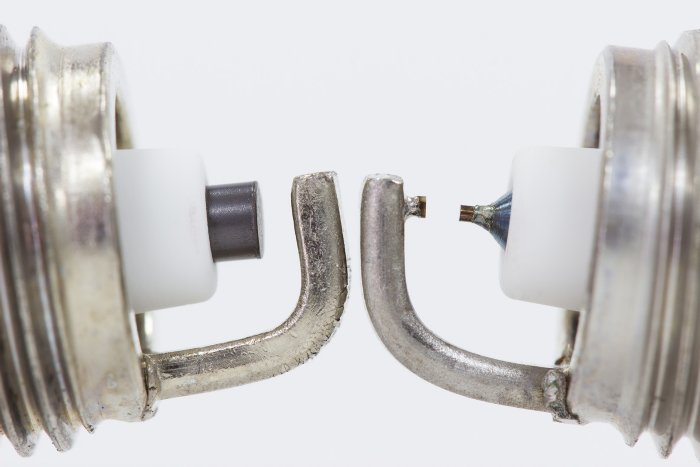
Although we sometimes think that spark plugs have only one function, which is to ignite the air/fuel mixture in petrol engines, the fact is that spark plugs have two functions in petrol engines. The first is to ignite the air/fuel mixture, and the second is to remove heat from the cylinders.
Both functions are crucially important for smooth and efficient engine operation in modern vehicles, and in this article, we will discuss how Bosch spark plugs accomplish these functions. Before we get to specifics though, we need to discuss arguably the most misunderstood aspect of spark plugs among the general public and mechanics alike, this aspect being-
The problem with spark plug heat ranges is not so much the fact that “hot” plugs don’t work well in cold engines, or that "cold" plugs don't work well in hot engines than it is about the fact that there is no single definition for the term, "heat range". Nonetheless, two common definitions of the term say that a spark plug’s heat range is a measure of the plug’s resistance to thermal shocks, while another holds that a spark plug’s heat range is an indication of the temperature at which a spark plug “burns” itself clean.
While both of the above definitions touch upon important aspects of modern spark design, neither of the above definitions is accurate or complete because neither definition takes account of the fact that no industry standard defines whether any given spark plug is "hot" or "cold". As a practical matter, all spark plug manufacturers are not only free to determine the extent of temperature steps from one heat grade to the next; spark plug manufacturers are also not obliged to follow a single numbering system for their products.
The practical upshot of this is that all spark plug manufacturers are free to number their products in any way they like, but since this article deals with Bosch spark plugs, we need not consider the numbering and naming conventions of other spark plug manufacturers, beyond saying that-
So, since this article is about Bosch spark plugs, let’s look at an example of how Bosch names/numbers spark plugs. Consider the image below-

Image source: https://www.boschsparkplugs.net/how-do-i-find-a-colder-or-hotter-plug-6
In all cases, the digit that indicates the heat range of a Bosch spark plug will be in the middle of the series of characters and symbols, such as the “6” shown in this example. It is worth noting that in the case of Bosch spark plugs, higher numbers denote higher temperature ranges, while lower numbers denote lower temperature ranges.
However, the “6” in this example does not convey useful information by itself, so let us consider the image below-

Image source: https://www.boschsparkplugs.net/what-is-a-spark-plugs-heat-range-2
It is universally accepted that combustion temperatures in petrol engines range from about 500 degrees Celsius to about 850 degrees Celsius. This range of temperatures covers all petrol engines; from small lawn mower engines to super powerful engines in hypercars, but the actual combustion temperature in any given engine can range over two hundred or more degrees during changes in engine operating conditions.
Moreover, apart from engine speeds and loads, combustion temperatures are also influenced by factors like (among many others) engine design, engine displacement, valve and ignition timing settings, the efficiency of exhaust manifolds, and fuel quality.
So, if we assume that a given engine has an average combustion temperature of say, 700 degrees Celsius, and we furthermore refer to the image above, the Bosch sparkplug in the middle will transfer some of the heat of the combustion process to the cylinder head at a rate that is fast enough ( as shown by the flowing green arrows) to prevent the ceramic tip that holds the centre electrode from melting. In this case, there is a balance between the rate at which the ceramic tip absorbs heat and the rate at which the ceramic tip transmits heat to the spark plug’s casing, through which heat is transferred to the cylinder head.
As a practical matter, this balance is achieved by the surface area of the ceramic tip that is directly exposed to combustion heat, although in some spark plug designs, the metallurgical composition of the centre electrode assists with heat transfer. Nonetheless, if we exchange the middle Bosch spark plug for the Bosch sparkplug on the left, the larger surface area of the exposed ceramic tip will overheat (and likely melt or fragment) before it can transit meaningful amounts of heat to the cylinder head.
Similarly, if we exchange the middle Bosch spark plug for the Bosch spark plug on the right, the smaller surface area of the exposed ceramic tip will not heat up enough to prevent the formation of carbon deposits on the tip, so the spark plug will become fouled very quickly.
Thus, in this example, the Bosch sparkplug on the left will be too “hot” for our hypothetical engine, while the Bosch spark plug on the right will be too “cold” for our hypothetical engine. In practice, most spark plugs will work in any engine, but it is only the spark plug with the correct heat range that will perform reliably and predictably over the entire operating range of an engine it was intended to be used in. Put differently, the above means that a Bosch spark plug that is too hot for a particular engine may cause fatal engine damage when the ceramic tip breaks off or melts, while a Bosch spark plug that is too cold for a particular engine will foul up very quickly, which causes poor combustion, misfires, oil dilution, and increased fuel consumption.
However, when we see a vehicle for the first time, it is by no means always certain that it is fitted with the correct spark plugs, whether the plugs in the vehicles are Bosch plugs or not. But there is a way to determine the correct plugs for the vehicle even if the manual or other service information is not immediately available.
By using this extremely helpful Bosch resource, it is possible to kind of reverse engineer a spark plug by entering some pertinent information about the plugs in the vehicle, even if they are not Bosch plugs. By completing all the fields, the look-up tool will recommend a Bosch equivalent for the plugs currently in the vehicle, which brings us to-
As mentioned elsewhere, there is no industry standard when it comes to how spark plugs are numbered, and as a result, spark plug numbering systems can sometimes be very confusing, but let us use the example spark plug from earlier to shed some light on the issue-
The number of the Bosch spark plug is FR6DC+, and by referring to the official Bosch numbering system, we see that this is a relatively simple spark plug, with the numbers meaning the following-
Note, though, that Bosch’s official numbering system contains several more categories of specifications that are not reflected in this example spark plug number. Nonetheless, this system contains all possible specifications that apply to all Bosch spark plugs, meaning that even the most convoluted spark plug numbers can easily be decoded by referring to this table of possible specifications, which is available here, which brings us to the topic of the-
Precious metals in Bosch spark plugs

Image source: https://www.boschsparkplugs.net/bosch-spark-plug-metal-types
The table above shows the various precious metals that Bosch currently incorporates into their spark plugs, but it is important to note that a) not all Bosch spark plugs contain all the precious metals listed here and, b) some categories of Bosch spark plugs may contain higher quantities of some listed precious metals than others.
As a practical matter, it is almost impossible for us as mechanics and technicians to determine how much of any given precious metal is in any given Bosch spark plug, since all spark plug manufacturers consider the exact metallurgical compositions of the alloys they use in their products as trade secrets. Nonetheless, let us look at why Bosch uses precious metals in their spark plugs, starting with-
Copper
Because copper is an excellent conductor, almost all commercially available spark plugs have a copper centre electrode. However, since copper is very soft and has a low resistance to spark erosion, copper centre electrodes are typically coated with a nickel-based alloy that is fused onto the copper. The nickel alloy coating serves to protect the copper electrode against spark erosion and oxidation, which greatly extends the useful life of the spark plug.
Iridium
Although many spark plug manufacturers, including Bosh, preferred using platinum centre electrode tips because of their extreme resistance to spark erosion and oxidation, progressively more harsh operating conditions in modern engines required an even more resistant material to prolong spark plug life.
As a result of more stringent operating conditions, spark plug manufacturers now make centre electrode tips out of iridium, which is at least six times harder and eight times stronger than platinum. Moreover, the melting point of iridium is several hundred degrees higher than that of platinum, and iridium is a vastly better conductor of electricity than platinum.
However, iridium is not without its drawbacks. In its pure form, it is very expensive and it oxidizes at high combustion temperatures, which means that it has to be alloyed with other precious metals such as platinum, yttrium, or rhodium, with the superior hardness of iridium in such alloys serving to increase the hardness and spark erosion resistance of the other metals in the alloy. In practice, such alloys produce spark plugs with useful lives of at least 150 000 km but be aware that the retail cost of Bosch iridium spark plugs is directly related to the amount of iridium in the plugs. Therefore, the higher the amount of iridium in the plugs, the more expensive they are.
Nickel
Although nickel is among the most commonly used precious metals in modern Bosch spark plugs, nickel does have some disadvantages. For instance, many other precious metals are better conductors than nickel, or are harder, and have a lower electrical resistance than nickel. As a result, many other precious metals are alloyed with nickel to improve and enhance the characteristics of nickel-coated centre electrodes.
Platinum
The extremely high melting point of platinum prevents Bosch spark plugs' electrodes from wearing as quickly as non-platinum spark plugs. It should be noted, though, that due to adverse chemical reactions between platinum and nitrous oxide, Bosch platinum spark plugs are not recommended for use in modified engines with nitrous injection systems. However, Bosch iridium spark plugs are safe to use with nitrous oxide.
Silver
Bosch silver spark plugs are recommended for use in high-revving motorcycle and boat engines, as well as in the high-compression engines of super and hypercars because these plugs deliver stronger ignition sparks, which reduces misfires and poor combustion at low engine speeds.
Yttrium
Since yttrium is a key component in superconductors, Bosch uses small amounts of yttrium in some high-performance spark plugs to resist oxidation and spark erosion, while maintaining high levels of electrical conductivity at all engine speeds and loads.
The above is the short version of why Bosch uses some precious metals in their spark plugs, but bear in mind that the presence (or otherwise) of any particular precious metal cannot be detected by a visual inspection of any spark plug. The only way to determine which precious metals are present in any Bosh spark plug is to refer to the table of specifications that is available here, which brings us to the topic of-

“Reading” spark plugs to diagnose some types of engine issues is fast becoming a lost art form but this is partly due to the facts that a) modern spark plugs last much longer than they used to, and b) modern spark plugs behave and wear differently than their predecessors did.
As a matter of fact, many issues with fuel consumption, ignition timing, combustion, and the mechanical condition of an engine can no longer be correlated with the condition of spark plugs, simply because some, if not most such issues no longer affect spark plugs in the same way they did 30 years ago.
Moreover, in many cases, using the wrong or unsuitable spark plugs in some engines can mimic the effects of poor combustion, abnormal fuel trims, incorrect ignition timing, or excessive mechanical wear in some engines. Therefore, the first step in diagnosing these kinds of issues should be verifying whether (or not) the engine was running with the correct or recommended spark plugs.
Verifying Bosch spark plug numbers is the easy part of this process, but Bosch marketing material and technical publications often use potentially confusing language in the technical descriptions of spark plugs, so let’s clear up some of this confusion by looking at what Bosch means when they describe their spark plugs. Let us start with-
Bosch Double-Iridium Pin-to-Pin Spark Plug
These plugs use ultra-fine iridium wire firing pins on both the centre and ground electrodes.
Bosch Double-Iridium Spark Plug
These plugs use slightly larger diameter iridium wire firing pins on both the centre and ground electrodes.
Bosch Double-Platinum Spark Plug
These spark plugs have firing pins made from platinum on both the centre and ground electrodes.
Bosch Iridium Spark Plug
These spark plugs have iridium wire firing pins only on the centre electrode.
Bosch Nickel Spark Plug
These spark plugs have ground electrodes made from a nickel-based alloy.
Bosch Silver Spark Plug
These spark plugs have solid silver electrodes, which makes them suitable for use in older European sports cars and smaller petrol engines in leisure vehicles, which leaves us with this-
Customers can sometimes not only have very strong preferences about which spark plugs they’d like to use in their vehicles, but they can also ask very pertinent questions when we try to “convert” them from using spark plug brands “X, Y, or Z” to using Bosch spark plugs instead.
With the above in mind, we hope that this article has given you some new insights into the world of Bosch spark plugs and that you'd now be in a position to answer your customers’ questions about spark plugs in general, and Bosch spark plugs in particular. To this end, it is perhaps worth mentioning that the Bosch spark plugs that are available in the aftermarket in Australia and NZ are identical to the spark plugs Bosch supplies to the OEM market in all respects. The only possible exception is price points being in favour of aftermarket vendors, which should go some way towards converting at least some of your customers to using Bosh spark plugs.